2019英语六级模拟试卷:词汇
- 格式:docx
- 大小:38.55 KB
- 文档页数:4
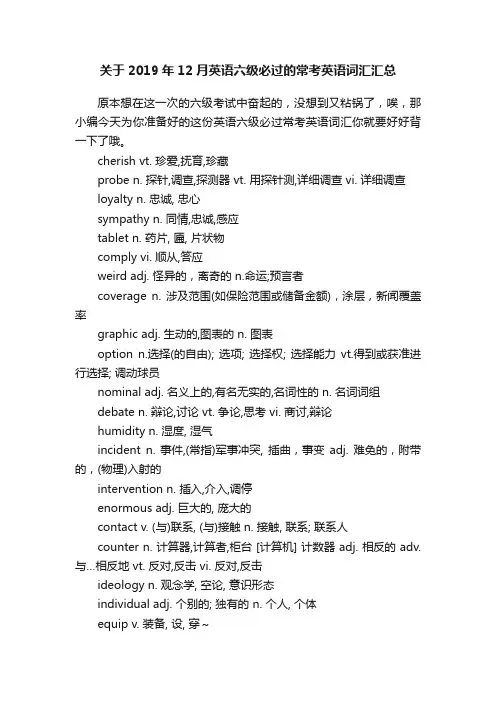
关于2019年12月英语六级必过的常考英语词汇汇总原本想在这一次的六级考试中奋起的,没想到又粘锅了,唉,那小编今天为你准备好的这份英语六级必过常考英语词汇你就要好好背一下了哦。
cherish vt. 珍爱,抚育,珍藏probe n. 探针,调查,探测器 vt. 用探针测,详细调查 vi. 详细调查loyalty n. 忠诚, 忠心sympathy n. 同情,忠诚,感应tablet n. 药片, 匾, 片状物comply vi. 顺从,答应weird adj. 怪异的,离奇的 n.命运;预言者coverage n. 涉及范围(如保险范围或储备金额),涂层,新闻覆盖率graphic adj. 生动的,图表的 n. 图表option n.选择(的自由); 选项; 选择权; 选择能力vt.得到或获准进行选择; 调动球员nominal adj. 名义上的,有名无实的,名词性的 n. 名词词组debate n. 辩论,讨论 vt. 争论,思考 vi. 商讨,辩论humidity n. 湿度, 湿气incident n. 事件,(常指)军事冲突, 插曲,事变adj. 难免的,附带的,(物理)入射的intervention n. 插入,介入,调停enormous adj. 巨大的, 庞大的contact v. (与)联系, (与)接触 n. 接触, 联系; 联系人counter n. 计算器,计算者,柜台 [计算机] 计数器 adj. 相反的 adv. 与…相反地 vt. 反对,反击 vi. 反对,反击ideology n. 观念学, 空论, 意识形态individual adj. 个别的; 独有的 n. 个人, 个体equip v. 装备, 设, 穿~velocity n. 速度, 速率, 迅速inevitable adj. 不可避免的, 必然(发生)的recession n. 后退,凹入的地方,不景气crowd n.人群; 群众; 一群 vi.拥挤,聚集 vt.挤满; 将…塞进; 催逼ridiculous adj. 可笑的;荒谬的robust adj. 强壮的,强健的,粗野的,需要体力的,浓的prose adj. 散文的 n. 散文cripple n. 跛者, 残废 v. 使...跛, 使...成残废, 削弱relay vt. 中继,用继电器控制,接替,传递 n. 替班人,接力赛,继电器,传递critical adj.批评的,爱挑剔的; 危险的,危急的; 决定性的; [物]临界的output n. 产量,输出,输出功率,输出端 vt. 输出(信息等)outset n. 开始, 开端consolidate v. 巩固,联合,统一 [计算机] 使固定outline n. 大纲,轮廓,概要,略图,素描 vt. 描画轮廓,描述要点rebellion n. 谋反, 叛乱, 反抗correlate n. 有相互关系的东西, 相关物 v. 使有相互关系, 互相有关系institute n. 学会,学院,协会 vt. 创立,开始,制定institution n. 机构,惯例,创立instrument n. 乐器, 工具, 仪器, 器械recover vt.恢复; 重新获得; 找回; <正>恢复(适当的状态或位置) vi.恢复健康(体力、能力等) n.恢复开始时姿势temper n. 脾气;(钢等)回火;性情;倾向 vt. 使回火;锻炼;调和;使缓和vi. 回火;调和exceed vt. 超过, 胜过, 超出界限 vi. 领先tempt vt. 诱惑;引起;冒…的风险;使感兴趣excess adj. 过量的,附加的 n. 超过,超越,过度,过量initiative adj. 创始的, 初步的, 自发的 n. 第一步, 首创精神; 主动权tendency n. 趋势,倾向current n. (水、气、电)流, 趋势 adj. 流通的, 现在的, 最近的ritual n. 仪式,典礼,宗教仪式,固定程序adj. 仪式的,依仪式而行的,老规矩的,惯常的revelation n. 揭露,泄露,发觉grant vt.承认; 同意; 准许; 授予 n.拨款; 补助金; 授给物(如财产、授地、专有权、补助、拨款等) vi.同意furnish vt. 布置,提供,装备region n. 地区,地域,地带,行政区turnover n. 翻覆, 翻折, 半圆卷饼, 营业额, 成交量 adj. 翻折的领子existence n. 存在, 生存grave adj.重大的,重要的; 严重的; [音乐]沉重的; (颜色等)朴素的adv.沉重地,庄重地; 极慢地n.坟墓,墓穴; 埋葬…的地方; 下场; 死亡vt.雕刻; 铭记cereal adj. 谷类(的),谷物(的) n. 谷类食物sculpture n. 雕塑 vt. 雕刻,雕塑 vi. 当雕刻师upgrade vt. 提高(上升,浓集,加强) n. 提高(上升,浓集,加强)vegetation n. 植物,草木,(植物)生长part n. 部份,零件,角色,部位 vt. 分开,分离,分配 vi. 分离,离开 adv. 部份地 adj. 分离的dedicate vt. 献出,提献辞,致力于relative adj. 相对的,比较的,涉及到的 n. 亲属,同类事物,相关物deficiency n. 缺乏,不足,缺点exploit n. 功绩,勋绩 vt.&vi. 开发,利用,开拓mental adj. 精神的,脑力的,精神错乱的,传心术的,[解剖学]颏的therefore adv. 因此, 所以relieve vt. 减轻,救济,解除issue n. 问题;流出;期号;发行物 vt. 发行,发布;发给;放出,排出 vi. 发行;流出;造成…结果;传下destined adj. 命中注定的, 去往 ... 的 destine的过去式和过去分词decade n. 十年levy n. 征税,召集 vt. 征收,发动(战争 vi. 强收presumably adv. 推测上,假定上,大概supervise vt. 监督,管理,指导mild adj. (烟、酒)味淡的,轻微的,温柔的,文雅的vivid adj. 生动的,强烈的,鲜艳的,清晰的,逼真的identicallysignify v. 象徵, 预示greed n. 贪心, 贪婪recall vt. 召回;回想起,记起;取消 n. 召回;回忆;撤消diagnose v. 诊断 vi. 判断,诊断(疾病) vt. 诊断(疾病)carve vt.& vi. 雕刻,切割slack n. 松弛的部分, 松散, 淡季, 中止 adj. 松弛的, 不流畅的 vt. 使缓慢, 疏忽 vi. 变松弛, 逃避工作deliver vt.发表; 递送; 交付; 使分娩 vi.投递; 传送solemn adj. 庄严的, 严肃的, 隆重的mission n. 任务,代表团,使命,传教 vt. 传教 [计算机] 使命peninsula n. 半岛reserve n. 预备品, 贮存, 候补 n. 克制, 含蓄 vt. 保留, 预订, 延期disproportionate adj. 不成比例的resident adj. 居住的 n. 居民,旅客snack n. 小吃,点心 v. 吃零食,吃点心moan n. 呻吟声, 悲叹声, 抱怨声 v. 抱怨, 呻吟 vi. 呻吟mobile adj. 可移动的,易变的,迁徙的, 流动的 n. (可随风飘动的)悬挂装置, 可动雕塑overpass n. 天桥, 立交桥 vt. 超越, 胜过, 忽略slump n. 暴跌,意气消沉,(土地)下沉 vi. 猛然掉落,坍塌,大幅度下跌desert n. 沙漠,荒地,应得(的惩罚或奖励)adj. 沙漠的,荒凉的vt. 遗弃vi. 擅离职守respectful adj. 表示尊敬的, 有礼貌的, 谦恭的modest adj. 谦虚的, 适度的, 端庄的wound vbl. 嗅出,吹号角(wind的过去式和过去分词) n. 创伤,伤害,苦痛 vt. &vi. 伤害identification n. 身份的证明 n. 视为同一,证明同一,确认。

2019年 6 月英语六级核心高频词汇Aaccelerate v. 加速affection n. 喜爱accessible a. 可接近的,可进入的acknowledge v. 感谢acquire v. 学会address v. 向⋯⋯讲话alert a. 活跃的 b. 机警的 c. 外国的allocate a. 准许 b. 位于 c. 分配appeal v. 有吸引力applicable a. 适用的assess v. 估价assumption n. 假定abnormal a. 不正常的abolish v. 废除absurd a. 荒唐的accommodate v. 提供膳宿addict v. 上瘾>I ’ m ~ed to computer games. Please save me!acquaint v. 使熟悉> Are you ~ed with that MM?adhere to v. 遵守>Adhere to your own principleadverse a. 不利的,有害的>Adverse circumstances can test a person ’ s wisdom and courage。
aggravate v. 加重 >Smoking ~s cold.alleviate v.减轻>No one can ~ my pain 。
alternate v./a交替(的)>a day of ~ sunshine and rain /Day and night ~amplify v. 扩大 (声音 )>anonymous a. 匿名的I received an ~ letter 。
applaud v.鼓掌;赞许>I ~your suggestion 。
apt a. 易于 >One is ~ to make mistakes if given too much pressure。
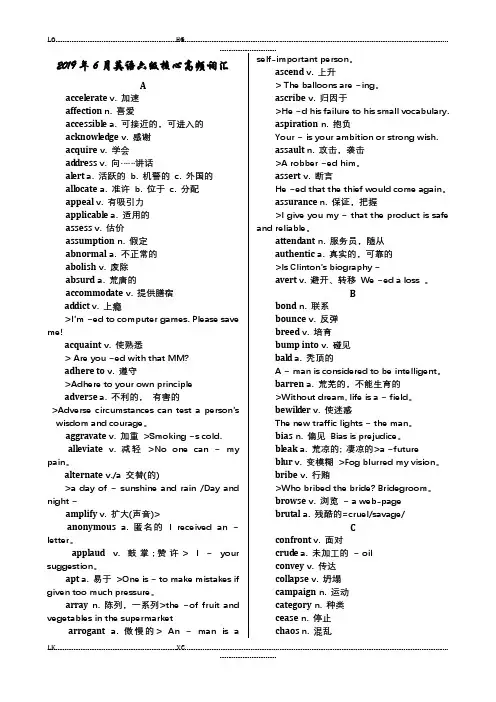
2019年6月英语六级核心高频词汇Aaccel erate v. 加速affection n. 喜爱accessibl e a. 可接近的,可进入的acknowl edge v. 感谢acquire v. 学会ad dress v. 向……讲话al ert a. 活跃的b. 机警的c. 外国的all ocate a. 准许b. 位于c. 分配appeal v. 有吸引力applicabl e a. 适用的assess v. 估价assumption n. 假定abnormal a. 不正常的abolish v. 废除absurd a. 荒唐的accommodate v. 提供膳宿ad dict v. 上瘾>I’m ~ed to computer games. Please save me!acquaint v. 使熟悉> Are you ~ed with that MM?adhere to v. 遵守>Adhere to your own principleadverse a. 不利的,有害的>Adverse circumstances can test a person’s wisdom and courage。
aggravate v. 加重>Smoking ~s cold.all eviate v. 减轻>No one can ~ my pain。
alternate v./a 交替(的)>a day of ~ sunshine and rain /Day and night ~amplify v. 扩大(声音)>anonymous a. 匿名的I received an ~ letter。
applaud v. 鼓掌;赞许> I ~ your suggestion。
apt a. 易于>One is ~ to make mistakes if given too much pressure。
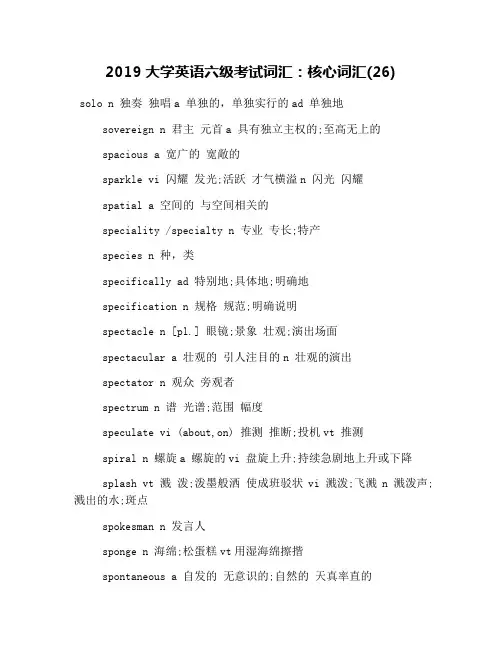
2019大学英语六级考试词汇:核心词汇(26)solo n 独奏独唱a 单独的,单独实行的ad 单独地sovereign n 君主元首a 具有独立主权的;至高无上的spacious a 宽广的宽敞的sparkle vi 闪耀发光;活跃才气横溢n 闪光闪耀spatial a 空间的与空间相关的speciality /specialty n 专业专长;特产species n 种,类specifically ad 特别地;具体地;明确地specification n 规格规范;明确说明spectacle n [pl.] 眼镜;景象壮观;演出场面spectacular a 壮观的引人注目的n 壮观的演出spectator n 观众旁观者spectrum n 谱光谱;范围幅度speculate vi (about,on) 推测推断;投机vt 推测spiral n 螺旋a 螺旋的vi 盘旋上升;持续急剧地上升或下降splash vt 溅泼;泼墨般洒使成班驳状vi 溅泼;飞溅n 溅泼声;溅出的水;斑点spokesman n 发言人sponge n 海绵;松蛋糕vt用湿海绵擦揩spontaneous a 自发的无意识的;自然的天真率直的spouse n 配偶spy n 间谍vi 当间谍;(on) 暗中监视vt 看见发现stabilize/-ise v 使稳定稳固stagger vi 摇晃蹒跚vt 使吃惊;使错开使交错staircase n 楼梯stall n货摊;[pl.] 正厅前座区v 熄火;拖延推迟startle vt 使惊吓吃惊stationayt a 固定的静止不动的statistics n 统计统计资料;统计学stereo a 立体声的n 立体声stereotype n 陈规老套固定的模式vt 对-形成固定看法stern a 严厉的严格的;坚定的n 船尾stimulus n 促动;刺激stitch v 缝绣n 一针线迹;缝法针法编结法;突然剧疼straightforward a 明确的简单的;正直的坦率的strategic a 对全局有重要意义的;战略上的streamline vt 使成流线型;精简使效率更高stride vi 大踏步走;(over,across) 跨越n 大步;步法步态;[pl.] 进展进步take in (one’s)- 一跨而过轻而易举地做sriking a 显著的突出的;惹人注目的容貌出众的strive vi 努力奋斗力求stubborn a 顽固的执拗的倔强的;难对付的难于克服的studio n 画室摄影室;播音室录音室摄影朋stumble vi 绊脚绊倒;跌跌撞撞地走;结结巴巴地诵读–across/on 偶然遇到碰巧找到sturdy a 强壮的结实的坚固的;坚定的坚强的subjective a 主观的个人的。

2019年12月英语六级考试模拟题及答案解析(3)Part Ⅱ Reading Comprehension (35 minutes)Directions: There are four passages in this part. Each passage is followed by some questions or unfinished statements. For each of them there are four choices marked A), B), C) and D). You should decide on the best choice and mark the corresponding letter on the Answer Sheet with a singleline through the centre. Questions 21 to 23 are based on the following passage:The Caledonian Market in London is a clearing house ofthe junk (旧货、废弃物 ) of the universe. Here, rubbish is a commodity and rubbish picking is a sport. Somebody, somewhere, wanted these things, perhaps just to look at. You learn here the incredible obscurity of human needs and desires. People grope (摸索), with fascinated curiosity, among the turned瞣ut debris (废墟) of thousands of attic rooms. Junk pours in twice a week, year in and year out. The Market is the penultimate (倒数第二的) resting place of banished vases, musical instruments that will not play, sewing machines that will not sew, paralyzed perambulator, epileptic bicycles and numerous other articles from which all morale and hope have long departed. There are stories of fortunes being picked upin the Market. Once seven hundred gold sovereigns were foundin a secret drawer of a crazy old bureau. And book buyershave discovered valuable editions of Milton and Dickens and Carlyla. There is nothing one can not buy in the Market.21. The title below that best expresses the idea of this passage is ____.A) Why People Buy What They DoB) Reflections on A Famous Junk MarketC) The Cause for Fascinated CuriosityD) What Happens to Attic Debris22. The articles for sale in the Caledonian Market ____.A) are wanted to look atB) are collected 100 times a yearC) reveal obscure needs and desiresD) bring fortune to the buyers23. From the style of this passage one might assume that it was taken from ____.A) a report on marketingB) a guide bookC) directions for a stage settingD) an information essayQuestions 24 to 30 are based on the following passage: Allelomimetic behavior may be defined as behavior in which two or more individual animals do the same thing, with some degree of mutual simulation and coordination. It can only involve in species with sense organs that are well enough developed so that continuous sensory contact can bemaintained. It is found primarily in vertebrates(脊椎动物), in those species that are diurnal, and usually in those that spend much of their lives in the air, in open water or on open plains. In birds, allelomimetic behavior is the rule rather than the exception, though it may occasionally be limited to particular seasons of the year as it is in the redwing blackbird. Its principal function is that of providing safety from predators(掠食者), partly because the flock can rely on many pairs of eyes to watch for enemies, and partly because if one bird reacts to danger, the whole flock is warned. Among mammals, allelomimetic behavior is very rare in rodents(啮齿动物), which almost never move in flocks or herds. Even when they are artificially crowded together, they do not conform in their movements. On the other hand, such behavior is a major system among large hoofed mammals,such as sheep. In the pack huntingcarnivores(食肉类飞禽), allelomimetic behavior has another function of cooperative hunting for large prey(被捕食者) animals,such as moose. Wolves also defend their dens as a group against larger predators, such as bears. Finally, allelomimetic behavior is highly developed among most primate groups, where it has the principal function of providing warning against predators,as though combined defensive behavior is also seen in troops of baboons(狒狒).。
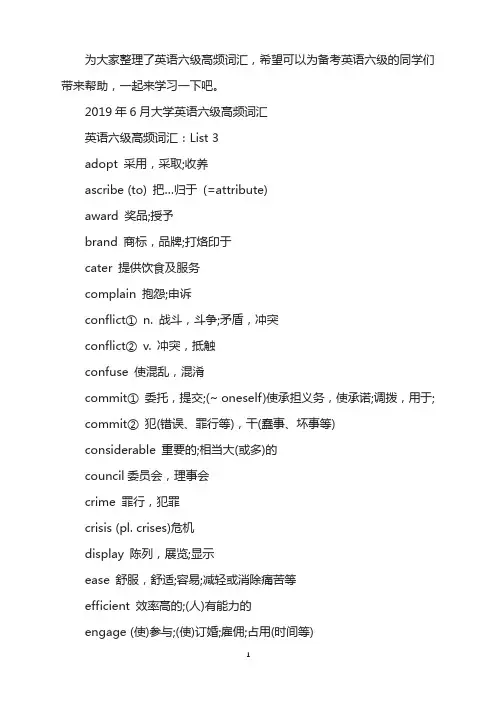
为大家整理了英语六级高频词汇,希望可以为备考英语六级的同学们带来帮助,一起来学习一下吧。
2019年6月大学英语六级高频词汇
英语六级高频词汇:List 3
adopt 采用,采取;收养
ascribe (to) 把…归于(=attribute)
award 奖品;授予
brand 商标,品牌;打烙印于
cater 提供饮食及服务
complain 抱怨;申诉
conflict①n. 战斗,斗争;矛盾,冲突
conflict②v. 冲突,抵触
confuse 使混乱,混淆
commit①委托,提交;(~ oneself)使承担义务,使承诺;调拨,用于;
commit②犯(错误、罪行等),干(蠢事、坏事等)
considerable 重要的;相当大(或多)的
council委员会,理事会
crime 罪行,犯罪
crisis (pl. crises)危机
display 陈列,展览;显示
ease 舒服,舒适;容易;减轻或消除痛苦等
efficient 效率高的;(人)有能力的
engage (使)参与;(使)订婚;雇佣;占用(时间等)
enhance 提高,增强
establish 建立;确定;安置
expand (使)膨胀,(使)扩张;张开,展开expose 暴露;揭露;曝光,陈列
grant 助学金;同意,准予;给予individual 个人;单独的,个人的;独特的instal (l) 安装,设置
lobby 前厅;(会议)休息室;游说observe 观察;遵守,奉行(仪式等) obvious 明显的,显而易见的
online 联机的(地)。
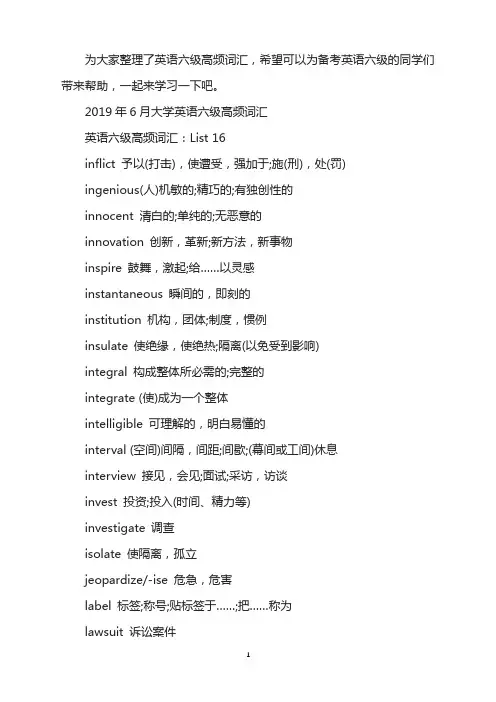
为大家整理了英语六级高频词汇,希望可以为备考英语六级的同学们带来帮助,一起来学习一下吧。
2019年6月大学英语六级高频词汇英语六级高频词汇:List 16inflict 予以(打击),使遭受,强加于;施(刑),处(罚)ingenious(人)机敏的;精巧的;有独创性的innocent 清白的;单纯的;无恶意的innovation 创新,革新;新方法,新事物inspire 鼓舞,激起;给……以灵感instantaneous 瞬间的,即刻的institution 机构,团体;制度,惯例insulate 使绝缘,使绝热;隔离(以免受到影响)integral 构成整体所必需的;完整的integrate (使)成为一个整体intelligible 可理解的,明白易懂的interval (空间)间隔,间距;间歇;(幕间或工间)休息interview 接见,会见;面试;采访,访谈invest 投资;投入(时间、精力等)investigate 调查isolate 使隔离,孤立jeopardize/-ise 危急,危害label 标签;称号;贴标签于……;把……称为lawsuit 诉讼案件leap (leapt/leaped; leapt/leaped)跳,跳跃lease 租赁,租约;出租legal 法律的,法定的;合法的,正当的(=lawful)lest 唯恐,免得liable 有责任的;有……倾向的;可能的linger 继续逗留,徘徊;继续存留,缓慢消失;磨蹭,拖延;苟延残喘loan 贷款,借出物;借出magnify 放大,扩大majority 多数,大多数mature 熟的;成熟的;成年人的maximum 最大值,极限;最大的。
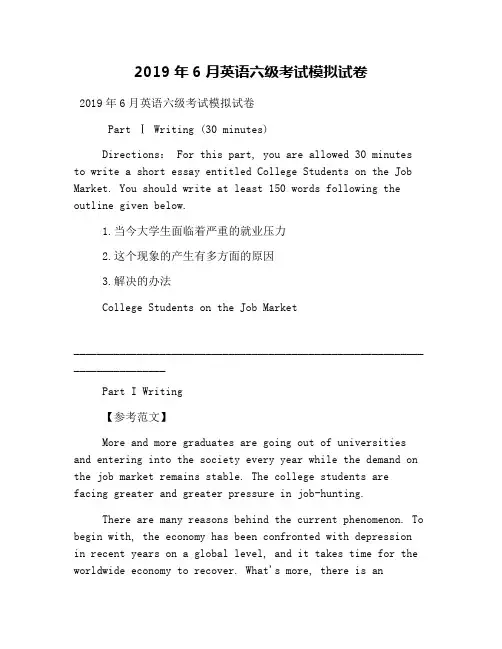
2019年6月英语六级考试模拟试卷2019年6月英语六级考试模拟试卷Part Ⅰ Writing (30 minutes)Directions: For this part, you are allowed 30 minutes to write a short essay entitled College Students on the Job Market. You should write at least 150 words following the outline given below.1.当今大学生面临着严重的就业压力2.这个现象的产生有多方面的原因3.解决的办法College Students on the Job Market_____________________________________________________________ ________________Part I Writing【参考范文】More and more graduates are going out of universities and entering into the society every year while the demand on the job market remains stable. The college students are facing greater and greater pressure in job-hunting.There are many reasons behind the current phenomenon. To begin with, the economy has been confronted with depressionin recent years on a global level, and it takes time for the worldwide economy to recover. What's more, there is anelement of irrationality in the enrollment of the campuses. Some hot majors have enrolled too many students, and many people compete for one position after graduation, whereas the majors with little attention have few students, and more graduates are needed than the campus can supply.The solution to this problem lies with both the government as a whole and the individual in specific. The government takes whatever measures possible to help the economy recover and to create more job opportunities for the applicants. And for the individual students, it is better to study what they are interested in and to gain experience through practice, thus better prepared for the society.Part ⅡReading Comprehension (Skimming and Scanning) (15 minutes)Directions: In this part, you will have 15 minutes to go over the passage quickly and answer the questions on Answer Sheet 1. For questions 1-7, choose the best answer from the four choices marked A), B), C) and D). For questions 8-10, complete the sentences with the information given in the passage.Will Electronic Medical Records Improve Health Care?Electronic health records (EHRs) have received a lot of attention since the Obama administration committed $19billion in stimulus funds earlier this year to encourage hospitals and health care facilities to digitize patient data and make better use of information technology. The healthcare industry as a whole, however, has been slow to adopt information technology and integrate computer systems,raising the question of whether the push to digitize will result in information that empowers doctors to make better-informed decisions or a morass of disconnected data.The University of Pittsburgh Medical Center (UPMC) knows firsthand how difficult it is to achieve the former, and how easily an EHR plan can fall into the latter. UPMC has spent five years and more than $1 billion on information technology systems to get ahead of the EHR issue. While that is more than five times as much as recent estimates say it should cost a hospital system, UPMC is a mammoth network consisting of 20 hospitals as well as 400 doctors' offices, outpatient sites and long-term care facilities employing about 50,000 people.UPMC's early attempts to create a universal EHR system, such as its ambulatory electronic medical records rolled out between 2000 and 2005, were met with resistance as doctors, staff and other users either avoided using the new technology altogether or clung to individual, disconnected software and systems that UPMC's IT department had implemented over the years.On the mendAlthough UPMC began digitizing some of its records in 1996, the turning point in its efforts came in 2004 with the rollout of its eRecord system across the entire health care network. eRecord now contains more than 3.6 millionelectronic patient records, including images and CT scans, clinical laboratory information, radiology data, and apicture archival and communication system that digitizes images and makes them available on PCs. The EHR system has29,000 users, including more than 5,000 physicians employedby or affiliated with UPMC.If UPMC makes EHR systems look easy, don't be fooled, cautions UPMC chief medical information officer Dan Martich, who says the health care network's IT systems require a "huge, ongoing effort" to ensure that those systems can communicate with one another. One of the main reasons is that UPMC, like many other health care organizations, uses a number ofdifferent vendors for its medical and IT systems, leaving the integration largely up to the IT staff.Since doctors typically do not want to change the waythey work for the sake of a computer system, the success ofan EHR program is dictated not only by the presence of the technology but also by how well the doctors are trained on, and use, the technology. Physicians need to see the benefitsof using EHR systems both persistently and consistently, says Louis Baverso, chief information officer at UPMC's Magee-Women's Hospital. But these benefits might not be obvious at first, he says, adding, "What doctors see in the beginning is that they're losing their ability to work with paper documents, which has been so valuable to them up until now."Opportunities and costsGiven the lack of EHR adoption throughout the healthcare world, there are a lot of opportunities to get thisright (or wrong). Less than 10 percent of U.S. hospitals have adopted electronic medical records even in the most basic way, according to a study authored by Ashish Jha, associate professor of health policy and management at Harvard Schoolof Public Health. Only 1.5 percent have adopted acomprehensive system of electronic records that includes physicians' notes and orders and decision support systemsthat alert doctors of potential drug interactions or other problems that might result from their intended orders.Cost is the primary factor stalling EHR systems, followed by resistance from physicians unwilling to adopt new technologies and a lack of staff with adequate IT expertise, according to Jha. He indicated that a hospital could spend from $20 million to $200 million to implement an electronic record system over several years, depending on the size of the hospital. A typical doctor's office would cost an estimated $50,000 to outfit with an EHR system.The upside of EHR systems is more difficult to quantify. Although some estimates say that hospitals and doctor's offices could save as much as $100 million annually by moving to EHRs, the mere act of implementing the technology guarantees neither cost savings nor improvements in care, Jha said during a Harvard School of Public Health community forum on September 17. Another Harvard study of hospital computerization likewise determined that cutting costs and improving care through health IT as it exists today is "wishful thinking". This study was led by David Himmelstein, associate professor at Harvard Medical School.The cost of getting it wrongThe difference between the projected cost savings and the reality of the situation stems from the fact that the EHR technologies implemented to date have not been designed to save money or improve patient care, says Leonard D'Avolio, associate center director of Biomedical Informatics at theMassachusetts Veterans Epidemiology Research and Information Center (MAVERIC). Instead, EHRs are used to documentindividual patients' conditions, pass this information among clinicians treating those patients, justify financial reimbursement and serve as the legal records of events.This is because, if a health care facility has $1million to spend, its managers are more likely to spend it on an expensive piece of lab equipment than on information technology, D'Avolio says, adding that the investment on lab equipment can be made up by charging patients access to it as a billable service. This is not the case for IT. Also, computers and networks used throughout hospitals and health care facilities are disconnected and often manufactured by different vendors without a standardized way of communicating. "Medical data is difficult to standardize because caring for patients is a complex process," he says. "We need to findsome way of reaching across not just departments but entire hospitals. If you can't measure something, you can't improve it, and without access to this data, you can't measure it."To qualify for a piece of the $19 billion being offered through the American Recovery and Reinvestment Act (ARRA), healthcare facilities will have to justify the significanceof their IT investments to ensure they are "meaningful users" of EHRs. The Department of Health and Human Services has yetto define what it considers meaningful useAggregating info to create knowledgeIdeally, in addition to providing doctors with basic information about their patients, databases of vital signs, images, laboratory values, medications, diseases,interventions, and patient demographic information could be mined for new knowledge, D'Avolio says. "With just a few of these databases networked together, the power to improve health care increases exponentially," D'Avolio suggested. "All that is missing is the collective realization thatbetter health care requires access to better information—not automation of the status quo." Down the road, the addition of genomic information, environmental factors and family history to these databases will enable clinicians to begin to realize the potential of personalized medicine, he added.1. In America, it is slow to adopt information technology because —————.A) the funds invested by the government is not enough in the pastB) EHRs have received less attention of the public in the pastC) whether it will be useful to doctors or not is doubtfulD) UPMC knows how difficult it is to digitize the hospital2. The University of Pittsburgh Medical Center (UPMC) —————.A) is the first medical center to adopt information technologyB) satisfy the requirement of the government on information technologyC) spent less money on information technology than it was estimatedD) attempted to created a universal EHR system, but met some difficulties3. The health care network’s IT systems require a lot of effort to ensure it can communicate with one another mainly because —————..A) the integration among different system is largely up to the IT staffB) UPMC is like many other health care organizations in the United StatesC) UPMC makes EHR systems look easyD) UMPC began digitizing some of its records in 19964. The success of the EHR program is decided by —————..A) the fact whether the information technology is available or notB) the fact how well the doctors are trained to use the information technologyC) not only the presence of the technology but the doctor’s training on technologyD) the fact whether physicians can see the benefits of using EHR systems5. The most important reason of most hospitals being reluctant to adopt EHR system is that —————.A) the cost is too high for the hospital to affordB) physicians are unwilling to adopt itC) there is a lack of staff with adequate IT expertiseD) doctor worry about its negative influence on patients6. According to the study led by David Himmelstein through health IT —————.A) it is possible to cut the costs of the hospitalB) it is possible to improve the health careC) it ensure neither cost saving nor improvement in careD) it could save as much as $100 million annually7. The hospital’s managers prefer to —————.A) spend money on an expensive piece of equipment than on information technologyB) charge patients access to the information technology as a billable serviceC) purchase the information technology to improve the health care of the hospitalD) invest more money on the training of the physicians to charge patients more money8. Jha said the mere act of implementing the technology guarantees ______________________.9. D'Avolio says the investment on lab equipment can be made up by_____________________.10. Databases of vital signs, images, laboratory values, medications, diseases, interventions, and patient demographic information could be ____________________.Part II Reading Comprehension (Skimming and Scanning)原文精译【1】给自己的事业买的保险消防队无意之中淹没了Mad Gab's的总部,Mad Gab's是Gabrielle Melchionda二十多年前建立的美容公司。
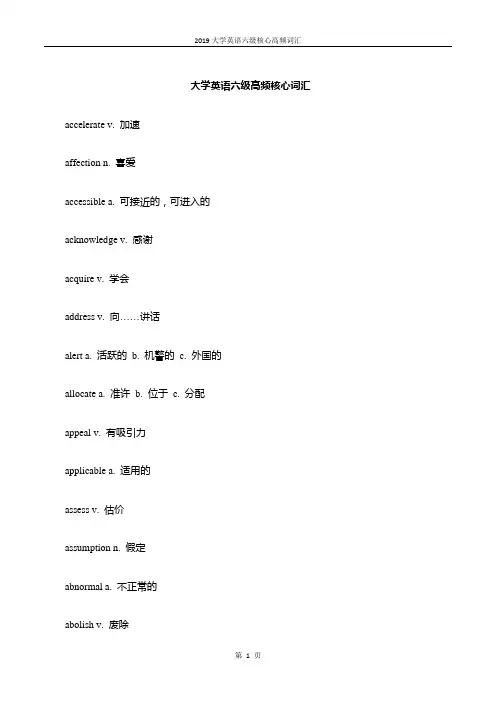
大学英语六级高频核心词汇accelerate v. 加速affection n. 喜爱accessible a. 可接近的,可进入的acknowledge v. 感谢acquire v. 学会address v. 向……讲话alert a. 活跃的b. 机警的c. 外国的allocate a. 准许b. 位于c. 分配appeal v. 有吸引力applicable a. 适用的assess v. 估价assumption n. 假定abnormal a. 不正常的abolish v. 废除absurd a. 荒唐的accommodate v. 提供膳宿addict v. 上瘾>I’m ~ed to computer games. Please save me!acquaint v. 使熟悉> Are you ~ed with that MM?adhere to v. 遵守>Adhere to your own principleadverse a. 不利的,有害的>Adverse circumstances can test a person’s wisdom and courage。
aggravate v. 加重>Smoking ~s cold.alleviate v. 减轻>No one can ~ my pain。
alternate v./a 交替(的) >a day of ~ sunshine and rain /Day and night ~amplify v. 扩大(声音)>anonymous a. 匿名的I received an ~ letter。
applaud v. 鼓掌;赞许> I ~ your suggestion。
apt a. 易于>One is ~ to make mistakes if given too much pressure。

19年12月六级真题词汇2019年12月六级真题词汇11. shrink /ʃrɪŋk/ v.缩小,收缩2. accompany /əˈkʌmpəni/ 陪伴;伴奏3. mortgage /ˈmɔːɡɪdʒ/ v./n. 抵押4. apparent /əˈpærənt/ adj.表面上的,显然的5. revitalize /ˌri:ˈvaɪtəlaɪz/ v.使复活,复兴6. weed /wiːd/ n.野草 v.除草7. defective /d ɪˈfekt ɪv/ adj.有缺陷的8. misguide [m ɪs'ga ɪd] v.误导9. deprivation /ˌdeprɪˈveɪʃn/ n.缺乏,丧失 10. breach /bri:tʃ/ v./n.违背,违反 11. pop up 突然出现12. substitute /ˈsʌbstɪtju:t/ v.代替 n.代替品 13. warrant /ˈwɒrənt/ n.授权令;依据 14. concede /kənˈsi:d/ v.承认,让步15. exceed /ɪkˈsiːd/ v.超过,超越 16. fetch /fetʃ/ v.拿来;售得,卖得... 17. margin /ˈmɑ:dʒɪn/ n.空白,差额 18. confinement /kənˈfaɪnmənt/ n.监禁,禁闭 19. commodity /kəˈmɒdəti/ n.商品,日用品有道考神更懂考试20. surplus /ˈsɜ:pləs/ n.剩余,盈余 21. viable /ˈvaɪəbl/ adj.可行的,可实施的 22. pledge /pledʒ/ v./n.保证;抵押23. project /ˈprɒdʒekt/ n.方案 /prəˈdʒekt/ v.投射;预想 24. holistic /həˈlɪstɪk/ adj.整体的25. degradation /ˌdeɡrəˈdeɪʃn/ n.退化,降级 26. alleviate /əˈli:vieɪt/ v.减轻,缓和 27. downside /ˈdaʊnsaɪd/ n.缺点,不利方面 28. assess /əˈses/ v.评定,评估 29. mediate /ˈmi:dieɪt/ v.调停 30. eternal /ɪˈtɜ:nl/ adj.永恒的31. shelter /ˈʃeltə(r)/ n.避难处 v.保护,躲避32. discrepancy /dɪˈskrepənsi/ n.差异,不一致33. startle /ˈstɑ:tl/ v.使惊吓2019年12月六级真题词汇21. better-off /'betə'ɔf/ adj.较富裕的2. ingenuity /ˌɪndʒəˈnju:əti/ n.聪明才智3. applaud /əˈplɔːd/ v.鼓掌,称赞4. proceed /prəˈsi:d/ v.继续,前进 n.收益5. pool /puːl/ v.集中资源(或材料等)6. extend /ɪkˈstend/ v.延展;延长,延伸有道考神更懂考试7. justify /ˈdʒʌstɪfaɪ/ v.证明...正确,对...作出解释 8. board and lodge 供应食宿9. ignore /ɪɡˈnɔ:(r)/ v.忽视,对...不理会 10. exotic /ɪɡˈzɒtɪk/ adj.奇异的;异国风味的 11. privilege /ˈprɪvəlɪdʒ/ n.特权,优待 12. wipe out 消灭,彻底摧毁 13. plight /plaɪt/ n.困境,苦难 14. relocate /ˌriːləʊˈkeɪt/ v.搬迁;迁移 15. on the verge of 濒临于...,接近于... 16. fatal /ˈfeɪtl/ adj.致命的,灾难性的 17. reluctant /rɪˈlʌktənt/ adj.不情愿的18. prosperity /prɒˈsperəti/ n.繁荣;兴旺19. entitle /ɪnˈtaɪtl/ v.使享有权利,给...命名20. tiresome /ˈtaɪəsəm/ adj.凡人的,无聊的 21. persistence /pəˈsɪstəns/ n.坚持;维持 22. competence /ˈkɒmpɪtəns/ n.能力,胜任 23. outperform /ˌaʊtpəˈfɔːm/ v.做得比...好24. renovate /ˈrenəveɪt/ v.更新,修复 25. consist /kənˈsɪst/ v.由...组成;存在于26. distinguish /dɪˈstɪŋɡwɪʃ/ v.区分,辨别;使杰出 27. melody /ˈmelədi/ n.旋律,歌曲 28. beat /bi:t/ v.打赢 n.节拍,一击,一振有道考神更懂考试29. deprive /dɪˈpraɪv/ v.剥夺;使丧失30. insufficient /ˌɪnsəˈfɪʃnt/ adj.不足的,不能胜任的 31. obesity /əʊˈbi:səti/ n.肥胖 32. assign /əˈsaɪn/ v.分配;指派 33. designate /ˈdezɪɡneɪt/ v.指定;指派34. conspicuously /kənˈspɪkjuəsli/ adv.明显地;显著地 35. deficit /ˈdefɪsɪt/ n.赤字;亏损 36. excel /ɪkˈsel/ v.擅长;突出 37. loophole /ˈlu:phəʊl/ n.漏洞2019年12月六级真题词汇31.detrimental /ˌdetrɪˈmentl/ adj.有害的,不利的 2.digestion /daɪˈdʒestʃən/ n.消化 3.suspect /səˈspekt/ v.怀疑4.suspicious /səˈspɪʃəs/ adj.怀疑的,多疑的 5.contentious /kənˈtenʃəs/ adj.可能引起争议的 6.uncover /ʌnˈkʌvə(r)/ v.揭露;揭发7.plausible /ˈplɔ:zəbl/ adj.可信的;花言巧语的 8.plausibility /ˌplɔːzəˈbɪləti/ n.似乎有理,貌似可信 9.contradict /ˌkɒntrəˈdɪkt/ v.反驳;否定 10.casualty /ˈkæʒuəlti/ n.伤员;遇难者 11.recession /rɪˈseʃn/ n.经济衰退有道考神更懂考试12.crude /kru:d/ adj.粗糙的;天然的 13.barrier /ˈbæriə(r)/ n.障碍物;屏障 14.flourish /ˈflʌrɪʃ/ v.繁荣;昌盛 15.avert /əˈvɜ:t/ v.防止,避免;转移目光16.sophisticated /səˈfɪstɪkeɪtɪd/ adj.老练的,见多识广的;先进的 17.perspective /pəˈspektɪv/ n.态度,观点,透视法 18.manipulate /məˈnɪpjuleɪt/ v.操控;使用 19.self-regulate v.自我调节 20.falsehood /ˈfɔ:lshʊd/ n.谎言 21.indicate /ˈɪndɪkeɪt/ v.表明;显示 22.wear out 磨损;耗尽23.complacent /kəmˈpleɪsnt/ adj.自满的;得意的24.inevitable /ɪnˈevɪtəbl/ adj.不可避免的;必然的25.gigantic /dʒaɪˈɡæntɪk/ adj.巨大的 26.engage /ɪnˈɡeɪdʒ/ v.使从事,参加 27.magnitude /ˈmæɡnɪtju:d/ n.重大性;重大 28.underestimate /ˌʌndərˈestɪmeɪt/ v.低估;看轻29.rehearsal /rɪˈhɜːsl/ n.排练;预习 30.scenario /səˈnɑ:riəʊ/ n.设想;方案 31.evacuation /ɪˌvækjuˈeɪʃn/ n.疏散;撤离 32.metropolitan /ˌmetrəˈpɒlɪtən/ adj.大都市的 33.trigger /ˈtrɪɡə(r)/ n.扳机;诱因有道考神更懂考试2019年12月六级真题词汇41.coordinate /kəʊˈɔːdɪneɪt/ v.协调;使相配合 2.aftermath /ˈɑ:ftəmæθ/ n.后果;创伤 3.converge /kənˈvɜːdʒ/ v.集聚;汇集4.hospitable /hɒˈspɪtəbl/ adj.热情友好的;舒适的 5.purification /ˌpjʊərɪfɪˈkeɪʃn/ n.净化 6.abatement /əˈbeɪtmənt/ n.减少 7.airborne /ˈeəbɔ:n/ adj.空气传播的 8.vehicle /ˈviːəkl/ n.车辆;交通工具 9.traffic jam 交通堵塞10.premature /ˈpremətʃə(r)/ adj.不成熟的;过早的 11.supplement /ˈsʌplɪmənt/ n.增补物;添加物 12.nutrient /ˈnju:triənt/ n.营养物13.beneficial /ˌbenɪˈfɪʃl/ adj.有利的14.endurance /ɪnˈdjʊərəns/ n.忍耐力 15.replacement /rɪˈpleɪsmənt/ n.替换;更换 16.conduct /kənˈdʌkt/ v.实施;执行17.overdo /ˌəʊvəˈdu:/ v.做得过分;滥用 18.intake /ˈɪnteɪk/ n.吸入量 19.daunt /dɔːnt/ v.使胆怯;使气馁 20.in line with 符合,与...一致 21.refinement /rɪˈfaɪnmənt/ n.改善;精炼有道考神更懂考试22.reliable /rɪˈlaɪəbl/ adj.可靠的,可依赖的 23.option /ˈɒpʃn/ n.选择24.alternate /ɔ:lˈtɜ:nət/ adj.交替的 /ˈɔ:ltəneɪt/v.使交替 25.miniature/ˈmɪnətʃə(r) adj.微小的,微型的 n.微型 26.grab /ɡræb/ v./n.抓住;抓取 27.boom /bu:m/ v.繁荣,轰鸣 n.繁荣28.unprecedented /ʌnˈpresɪdentɪd/ adj.前所未有的 29.willpower /ˈwɪlpaʊə(r)/ n.意志力 30.embody /ɪmˈbɒdi/ v.体现31.aspiration /ˌæspəˈreɪʃn/ n.渴望;抱负 32.switch /swɪtʃ/ n./v.转换;转变33.synonymous /sɪˈnɒnɪməs/ adj.同义的34.haze /heɪz/ n.雾,霾有道考神更懂考试。
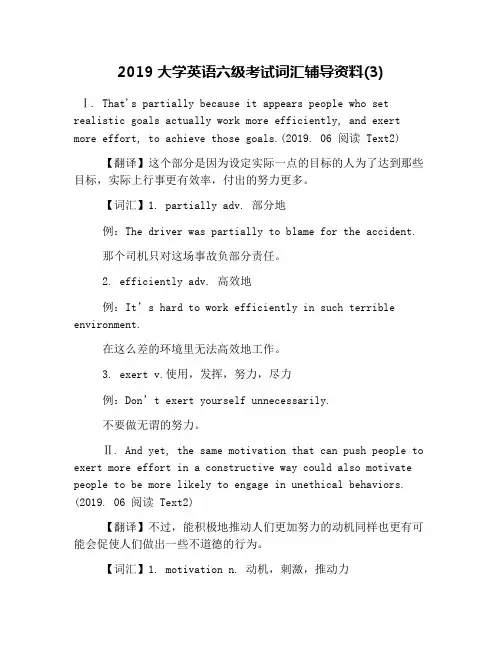
2019大学英语六级考试词汇辅导资料(3)Ⅰ. That's partially because it appears people who set realistic goals actually work more efficiently, and exert more effort, to achieve those goals.(2019. 06 阅读 Text2)【翻译】这个部分是因为设定实际一点的目标的人为了达到那些目标,实际上行事更有效率,付出的努力更多。
【词汇】1. partially adv. 部分地例:The driver was partially to blame for the accident.那个司机只对这场事故负部分责任。
2. efficiently adv. 高效地例:It’s hard to work efficiently in such terrible environment.在这么差的环境里无法高效地工作。
3. exert v.使用,发挥,努力,尽力例:Don’t e xert yourself unnecessarily.不要做无谓的努力。
Ⅱ. And yet, the same motivation that can push people to exert more effort in a constructive way could also motivate people to be more likely to engage in unethical behaviors. (2019. 06 阅读 Text2)【翻译】不过,能积极地推动人们更加努力的动机同样也更有可能会促使人们做出一些不道德的行为。
【词汇】1. motivation n. 动机,刺激,推动力例:Money is their chief motivation.金钱是他们的主要推动力。
2019六级考试词汇:核心词汇(18)medieval a 中世纪的,中古的Mediterranean n 地中海a 地中海的melody n 旋律,曲调membership n 会员身份,会籍;全体会员;会员数menace n 威胁,威吓;讨厌的人或物,造成麻烦的人或物vt 威胁,威吓merge v 使结合,合为一体mess n 凌乱状态;混乱的局面,困境;肮脏的东西v 弄乱,弄脏–about/around 浪费时间,闲荡;干预篡改;胡闹开玩笑;瞎弄摆弄–up 把-弄糟弄乱–with 干预打扰messenger n 送信人,信使metallic a 金属的,有金属特性的,像金属的metropolitan a 大城市的,大都会的midst n 中部中间当中in the –of 在-之中;正当-的时候migrate vi 移居(尤指移居国外),迁移;迁徙,移栖militant a 激进的n 激进分子mingle vt 使混合,使相混vi 混合起来,相混合;相交往miniature a 小型的微小的n 微小的模型,缩影minimal a 最小的,最低限度的minimize/-ise vt 使减少或缩小到最低限度;极力贬低,对-作最低估计misery n 痛苦,苦恼,苦难;悲惨的境遇,贫苦misfortune n 不幸,厄运,逆境;不幸事故,灾难,灾祸missionary n 传教士a 传教士的mobilize/-ise vt 动员;调动,鼓动起vi 动员起来moke v 嘲笑,讥笑,嘲弄a 仿制的,假装的;模拟的,演习的n [常pl.] 模拟考试momentum n 冲力,势头;动量monopoly n 垄断,专卖monster n 怪物;巨人,巨兽,巨大的东西a 巨大的,庞大的morality n道德道德性;德行,品行;道德规范,道德观mortal a 终有一死的;致命的;你死我活的,不共戴天的n 人,凡人mortgage n 抵押借款vt 抵押motel n 汽车旅馆mourn v 哀悼;对-感到痛心或遗憾muddy a 泥泞的,沾满烂泥的;(光,色泽)灰暗的,暗淡的vt 使(形势,争端等)显得扑朔迷离multitude n 人群,众多的人;大众,民众a-of 很多,大量municipal a 市政的,市办的,市营的murmur v/n 小声说话;小声抱怨,咕哝muscular a (相关)肌(肉)的;强有力的,坚强的,刚毅的mutter v/n 轻声低语,小声抱怨myth n 神话;虚构的信念(或观点,理论)N字部naive a 天真的,幼稚的narrative n 叙述文,故事;叙述,讲述nasty a 令人讨厌的;难弄的,困难的;严重的,凶险的necessitate vt 使成为必要,需要negligible a 可忽略不计的negotiate vt 谈判达成,洽谈,协商;顺利通过,成功越过vi 协商,谈判。
2019年大学英语六级词汇模拟题(7,8)你的六级次会过关了吗?来试试小编为你提供的2019年大学英语六级词汇模拟题(7-8)就知道了,看看你能考多少分呢?更多相关资讯,请关注网站更新。
2019年大学英语六级词汇模拟题(7)1. When her husband was given a job overseas, she had to decide whether toaccompany him or not.(A) go with (B) argue with (C) avoid2. In the middle of the night the sleeping campers were alarmed by a loud crash.(A) excited (B) signaled (C) frightened3. One of California's greatest problems is providing adequate water to meet the needs of its expanding population.(A) sufficient (B) palatable (C) suitable4. Although South Carolina's mineral resources are abundant, not all of them can be mined lucratively.(A) molten (B) plentiful (C) diverse5. While they were away on vacation, they allowed their mail to accumulate the post office.(A) pile up (B) get lost (C) be returned6. Lorraine Hansberry acquired a deep affection for Africa and its people from her uncle William, a professor of African history at Howard University.(A) respect (B) longing (C) fondness7. The accommodations of this hotel are limited to 600 persons.(A) epoches (B) lodgings (C) fiascoes8. Can you account for how the money got into your bag?(A) explain (B) tally (C) survey9. When transferred from one container to another of a different design, a liquid will maintain its volume but alter its shape.(A) modify(B)stretch (C) confine10. The road west gave access to the lake.(A) ascendancy (B) approach(C)exit11、The mystery story aroused my imagination.(A) stimulated (B) prolonged (C) glorified12、When you apply for a loan, you must show that you have asset to cover the amount of the loan(A) assessments (B) properties (C) legal documents13、Microfilm can hold a large amount of information in a very small storage space because the image is stored in reduced form.(A) packet (B) book (C) quantity14、The car was made in 1800; it is now regarded as an antique.(A) a product (B) a relic (C) a layman15. Attempts have been made for nearly three decades to increase the amount of precipitation from clouds by seeding them with salt or sliver iodide.(A) Devices (B) Hypotheses (C) Efforts16. The ropes are tightly anchored to the rock.(A) fastened (B) restricted (C) dragged17. The design of highways and expressways is dictated by terrain features and the anticipated volume of traffic.(A) desired (B) expected (C) erratic18. George Gershwin was the first American musician whose jazz compositions were seriously appreciated by concert audiences.(A) beard (B) sought (C) admired19. Walk softly as you approach the sleeping baby.(A)cross (B)drive against (C)near20. The Chinese people worship their ancestors.(A)forefathers (B)elders (C)heirs答案:1-10 ACABA CBAAB11-20 ABCBC ABCCA2019年大学英语六级词汇模拟题(8)1、Nashville, Tennessee, boasts some of the finest country music performers in the United States.(A) plays (B) attracts (C) contains2、The land crab, a forest floor scavenger(食腐动物)native to tropical America, migrates to the water to breed.(A) mate (B) swim (C) hatch3、The artist captured tire girl's personality in his photograph.(A) distorted (B) caught (C) masked4、Grocery prices were boosted again last month.(A) attacked (B) stabilized (C) raised5. The making of the movie Star Mars involved a blend of creativity and sophisticated computer technology.(A) combination (B) variety (C) organization6. Laser light beamed onto glass fibers casts a characteristic pattern.(A) projects (B) molds (C) cuts7. Communication is one of the most important bonds that hold cultural systems together.(A) obligations (B) qualities (C) links8、 Both of the drivers were injured in the collision.(A) hindrance (B)cry (C)crash9、Janet’s job as an assistant at the Harvard University observatory was toclassify stars according to their spectra.(A) locate (B)photograph (C)categorize10、In aerospace programs, helium(氦)is used to chill rocket engines prior to the launch.(A) cool (B) fuel (C) test11.Juries that decide civil and criminal cases are not compelled to reveal their reasons for a decision.(A) prepared (B) requested (C) forced12.In the system of ethics known as utilitarianism, the rightness or wrongness of an action is judged by its consequences.(A)cost (B) necessity (C) results13.Violet Oakley began her career as an illustrator, but later concentrated on murals and stained glass.(A) relied on (B) focused on (C) invested in14.The old, reliable company has conservative business methods.(A) reactionary (B) cautious (C) protective15.Will Rogers, an American humorist and social critic, became famous for his homespun humor and shrewd comments on current events.(A) stories (B) discussions (C) remarks16.In the early seventeenth century, the Iroquois Confederacy comprised the five nations of Mohawk, Oneida, Onondaga, Cayuga, and Seneca.(A) undermined (B) depended on (C) consisted of17.A chemical compound will take a crystalline from only under certain conditions such as freezing or evaporation.(A)recipe (B)formula (C)mixture18、Ballet is theatrical entertainment that combines the arts of dancing, stage design, and music.(A) replaces (B) promotes (C) blends答案:1-10 CABCA ACCCA11-18 CCBBC CCC。
为大家整理了英语六级高频词汇,希望可以为备考英语六级的同学们带来帮助,一起来学习一下吧。
2019年6月大学英语六级高频词汇英语六级高频词汇:List 6objective目标;客观的participate 参加,参与premium 奖品,奖金;额外津贴;高价的,优质的preserve 保护;保持;腌渍privilege 特权,特许;荣幸prompt 促进,激起;迅速的purchase 购买;购买的物品reflect 反射;反省,细想reject 拒绝;丢弃scan 细看,审视;浏览;扫描shift 移动;转嫁,转给;轮班,换班shortage 不足,缺少source 源(泉),源头;来源,出处(=origin)stuff 原料;填满;让…吃饱submit 呈送,提交;主张,建议;服从,屈服superior 卓越的,优良的;较…多的,优于;地位(或级别)较高的;上级,长官temper 脾气,情绪testify证实;说明threaten 威胁,恐吓;预示(某事)transform 使改变,使转化,使变化trend 趋势,倾向unique 唯一的;极不寻常的abandon 抛弃;放弃;放纵,纵情abundant 充分的,充裕的,丰富的accommodate 向…提供住处(或膳食);容纳,收容;顺应,适应accustom 使习惯acknowledge 承认…的权威(或主张);告知(信件、礼物等)已收到,确认;对(礼物)表示感谢acquire 取得,获得;学到aggressive 侵略的,好斗的;[褒]有进取心的alien 外国的;不相容的;(from) 相异的,陌生的;外侨,外来者;外星人。
为大家整理了英语六级阅读高频词汇,希望可以为备考英语六级的同学们带来帮助,一起来学习一下吧。
2019年6月大学英语六级阅读高频词汇汇总英语六级阅读高频词汇(14)651. faulty a. 有错误的,有缺点的652. favorable a. 称赞道;有利的,顺利的653. favorite a. 特别受喜欢的n. 喜爱的人或物654. gallery n. 画廊655. gallon n. 加仑656. gap n. 间隔,差距657. garbage n. 垃圾,废物658. gaze v. 凝视,注视659. gear n. 齿轮,传动装置660. gene n. 基因661. lest conj. 唯恐,免得662. liable a. 可能的,大概的; (to) 易于. . .663. liberal a. 自由得664. liberty n. 自由665. license/license n. 许可证,执照666. moisture n. 潮湿667. motivate vt. 激励,激发668. motive n. 动机,目的669. generate vt. 生成,产生(光、热、电等)670. genius n. 天才,天赋671. genuine a. 真的,真诚的672. gasoline n. 汽油673. germ n. 微生物,细菌674. gesture n. 姿势,手势675. giant a. 巨大的n. 巨人,巨物676. glimpse n. 一瞥,一看677. glory n. 光荣,荣誉678. glorious n. 光荣的,极好的679. golf n. 高尔夫球运动680. hydrogen n. 氢681. oxygen n. 氧682. hostile a. 敌对的,敌意大683. household n. 家庭,户684. hook n. 钩685. holy a. 神圣地,圣洁的686. hint n. 暗示,示意687. hesitate v. 犹豫688. highlight vt. 强调,突出689. hence ad. 因此,所以;今后,从此690. herd n. 兽群,牧群691. deliberately adv. 故意的692. attraction n. 吸引,吸引力693. destructive adj. 破坏性的694. starvation n. 饥饿,饿死695. exhaustion n. 竭力,疲惫696. strike n. 罢工v. 打击,罢工697. strength n. 力量,力气698. await vt. 等候699. deportation n. 放逐700. closed 关门。
2019英语六级模拟试卷:词汇
Part III Vocabulary
41. When they asked him about it, he said it was no _____ of theirs and wouldn't tell them anything.
A. concern
B. relation
C. connection
D. relevance
42. _____ the sense of someone watching them, Ralkph would have shouted at his wife.
A. Despite
B. But for
C. Except
D. Except for
43. The waltz and the tango seem to be out of fashion today. Things like the twist and jerk seem to be _____ young people are really interested in.
A. about all that
B. about that all
C. all that about
D. all about that
44. In his culture, _____ is was, this exchange of names on pieces of paper was probably a formal politeness, like saying "thank you".
A. all that
B. whichever
C. whatever
D. what
45. With the acquisition of smaller companies by larger ones, the 1960s saw a _____ of new conglomerates.
A. surge
B. suspension
C. dissolution
D. merging
46. You should _____ yourself of every chance to improve
your English.
A. indulge
B. endow
C. avail
D. assert
47. The _____ activities in rural societies are those involving the production of food and raw materials.
A. pleasant
B. predictable
C. presumable
D. predominant
48. One of the responsibilities of the Coast Guard is to make sure that all ships _____ follow traffic rules in busy harbors.
A. currently
B. obediently
C. randomly
D. frequently
49. What you say does not _____ the previous evidence.
A. stick to
B. consist in
C. accord with
D. associate with
50. We should _____ him with the facts of the case at once.
A. acquire
B. require
C. acquaint
D. inquire
51. We decided to _____ the program.
A. carry away
B. adhere to
C. give in
D. get at
52. He is very cute and always _____ giving offence.
A. cautious of
B. aware of
C. certain about
D. good at
53. Diamonds that are _____ or are too small for jewelry are used to cut very hard metals.
A. flawed
B. perfect
C. luminous
D. crude
54. Leaves are not distributed _____ on a plant stem, but are arranged in a very precise way that assures them the maximum light.
A. dangerously
B. randomly
C. densely
D. linearly
55. Accountants record all information _____ the economic aspects of an organization's activities.
A. submitted to
B. limiting
C. pertinent to
D. taxing
56. To become a soldier, he had to go through a _____ training period.
A. serious
B. rigorous
C. sober
D. radical
57. He _____ to preserve world peace by supporting the establishment of an organization to settle international disputes.
A. endeavored
B. suggested
C. plotted
D. tended
58. It took millions of years for order to grow out of the _____ of the universe.
A. adjustment
B. change
C. chaos
D. symmetry
59. Our club is _____ with a national organization of similar clubs.
A. affiliated
B. afforded
C. affected
D. afflicted
60. His behavior _____ from the rules.
A. deviated
B. separated
C. derived
D. detached
61. His musical talent remained _____ through a lack of training.
A. intact
B. invalid
C. latent
D. transient
62. They made the doors _____ the walls.
A. equal to
B. flush with
C. connected with
D. face to。